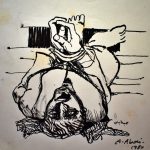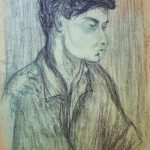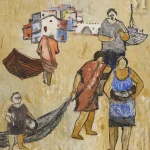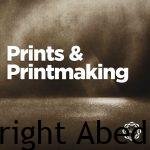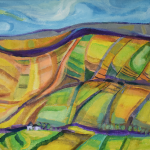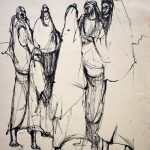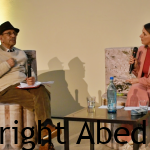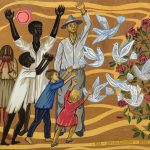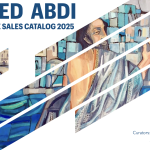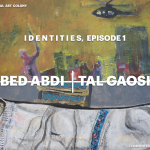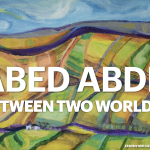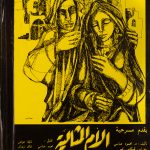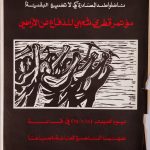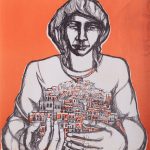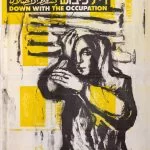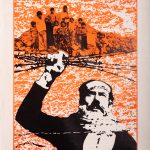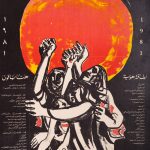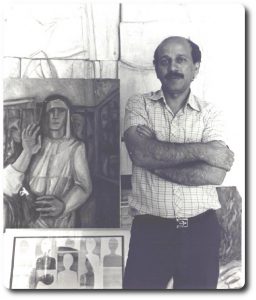
by Amir A. Abdi
 In 1962 my father held his first exhibition in Tel Aviv initiated by left-wing activists such as Gila Balas and her husband Shimon along with the poet Issam Al-Abassi and others. This event provided great cultural feedback as he was also elected to membership of the Artists Committee. He was twenty years old at the time and was the youngest and the first Arab artist to become a member of the committee.
In 1962 my father held his first exhibition in Tel Aviv initiated by left-wing activists such as Gila Balas and her husband Shimon along with the poet Issam Al-Abassi and others. This event provided great cultural feedback as he was also elected to membership of the Artists Committee. He was twenty years old at the time and was the youngest and the first Arab artist to become a member of the committee.
Reuven Rubin, Nahum Gutman and Yehoshua Grossbard were some of the well known artists who visited the exhibition, and Grossbard played a leading role in encouraging my father to study abroad. The poet Mahmoud Darwish published an interview he held with my father in the Al-Ittihad newspaper, in which he revealed the young artist’s desire and vision to enrich his cultural environment with artistic reality as he saw it. Mahmoud Darwish, Samih Al-Qasim, Emil Touma, Ibrahim Malik, Hanna Abou Hanna and Issam Al-Abasi all had a great influence on my father’s artistic life before his travels and after his return in 1971.
1. Academic Studies in Germany

Studying in Dresden was one of the most important stages in my father’s life, as it was his first encounter with a new culture. Dresden is characterized by its rich culture and tragic history, which are evident in the ruined buildings, the palaces of King Augustus II the Strong, Elector of Saxony and Poland, the museums and churches, which were destroyed in the Allied bombing of February 1945.
These scenes reminded my father of the Naqba and the exile of his family from Haifa to refugee camps in neighboring countries. Nevertheless, the cultural and social situation in Germany’s history prior to World War I, and the political situation led by the Weimar Republic, poverty, economic crisis and the awakening of artistic movements such as “Die Brücke” (The Bridge) and “Der Blaue Reiter” (The Blue Rider) that emerged in Dresden, all played a significant role in enriching the young artist’s vision, as well as Käthe Kollwitz’s black and white prints dealing with motherhood and poverty, and the 16th century works of Albrecht Dürer and Grünewald.
During his studies in Dresden, the young Abed Abdi was zealous and diligent in becoming acquainted with all aspects of the sculptural arts, including the baroque and neo-classical architectural arts.

In addition to the student’s good relationship with his professors, a special relationship bound Abdi culturally with Lea Grundig, since both were on the side of the nations opposed to imperialism, Israeli aggression on the Arab lands, and the Palestinian people being subjected to an occupation that still exists.
Also worthy of mention is his special relationship with a group of his professors, in particular his academic supervisor Prof. Gerhard Bondzin, who selected Abed Abdi, along with a group of other graduating students, to participate in the erection of a huge mural at the Cultural Palace ( Kulturpalast), built in 1968 in the center of Dresden, a mural which still remains a cultural landmark of this part of unified Germany.
The achievement of erecting this creative work, done with a group of artists, as well as the prize awarded by the state, contributed to formulating the future vision of Abed Abdi’s creativity for the public good, whereby visual art can contribute to the creation of artistic climates, which in turn give expression to the hopes of society in achieving development and welfare. Consequently, he set out the final design for his master’s diploma, which entailed the erection of the first monument entitled “Solidarity”, part of which was actually built on the campus of the academic institute in Erfurt. This was accompanied by his degree thesis, entitled “Monuments and Their Relation to Architectural and Social Spaces”.

In Abed Abdi’s cycle of illustrations entitled “The Refugees”, printed in black and white, which are part of the works he created towards the final stage of his studies, the figures playing their dramatic roles in the Palestinian landscape seem as if they are in the space of another world, taken perhaps from the German drama between 1905 and 1923 when Germany faced economic crisis and World War I, which led to the formation of the Weimar Republic. Also noteworthy is that Weimar was the birthplace of philosophers Goethe and Schiller.
While the young artist worked with the art of printing driven by premises connected with the case of his people – their episode as Palestinian refugees and the Six-Day War – and while he employed this art as a public vehicle to publish the works so they would reach the general public, the “protocols” of the manifesto of the German artistic movements, in particular the expressionist movements, were the initiators of this approach since art must be impulsive and able to recruit people.
The seven years Abed Abdi spent in this part of Germany made a great contribution in enabling him to gain knowledge and expertise in the fields of printing art techniques, lithographic printing and etching on copper and wood plates, as well as the art of net printing. In addition, Abdi learned aspects of sculpture, and later specialized in mural art. These specializations also contributed to opening up worlds which had been closed and unknown to him prior to his arrival to study.
These threads of the creative schools of art down the centuries had a visible impact on the works of Abed Abdi which he created during his studies in Dresden.
This is shown vividly in a collection of works printed on carved wood, bearing the title “Refugees from the So-called Six-Day War”, which is a group of six works in which he presents the Palestinian motif, showing the state of devastation and the dispersion of the Palestinian people as a result of Israeli aggression, a tragic motif that exists to this day.
2. Return to the Homeland

After returning to Haifa in 1971, my father began working at the Al-Ittihad and Al Jadid newspapers as a graphic designer and also as a teacher in cultural centers aiming to raise artistic awareness in the public and develop the art field towards building a museum and galleries for Arab society in the Galilee, “The Triangle” area and in cities with a mixed population.
In the defense of his diploma thesis, which was equivalent to a master’s degree, the art student explained the stages of the work as well as his future vision which he would pursue on returning to his homeland, and defining his targeted creativity for the public good.
In his reply to a question by one of the examining professors, he stated that
“the Palestinian minority in Israel does not have a museum, or an appropriate place to store our cultural and folk heritage, due to the policy of intentionally ignoring the Palestinian minority which has remained in its homeland. Additionally, the society of creative groups such as visual artists, musicians and actors, suffers from the lack of a supportive and encouraging public. Therefore my work will deal with the art of murals, the art of printing and posters, and will strive to transform the creative approach in the public sphere in order to create a cadre of young creative artists, as well as general consumers of art.”

In his introduction to the section on the underdeveloped state of Palestinian art in the Galilee, the artist Kamal Boullata, in a lecture he delivered at a convention of the Arab communities in the United States in 1975, which was published in a number of Arab newspapers and magazines, among them Al-Jadid published in Haifa, and which was translated by the late actress Bushra Karaman, stated:
“What draws attention in the appearance of Palestinian art by the Palestinian minority in Israel is the endeavor of a small group of young artists to study art at the academic level, and these are: the late Ibrahim Ibrahim from Reineh village in the Galilee, Abed Yunes from ‘Ar’ara village in the Triangle, Khalil Rayyan from the town of Tamra, and Abed Abdi, who returned from Germany several years ago. The latter has contributed in a special way in activating and recruiting artistic paths and young artist cadres, who began their careers in painting murals in the city of Nazareth and Kafr Yasif, where the first arts course was initiated and led by Abed Abdi, a course which is active in the creative and public fields”.
It is worthy of mention that this course was the nucleus from which well-known artists such as Ibrahim Nubani, Ilia Be’eni, Kamal Milhem, Samer Miari and
others graduated. It also served as the catalyst for the establishment in Kafr Yasif of the first Arab artists’ association, “Ibda’a”, in 1994.
2.1 The Land Day Monument
 The “Land Day” incidents in 1976 that led to the death of six Galilee and “Triangle” area residents was a major trigger for the Land Protection Committee
The “Land Day” incidents in 1976 that led to the death of six Galilee and “Triangle” area residents was a major trigger for the Land Protection Committee
to ask my father to build the first Palestinian monument in Sakhnin, which was erected in 1977.
As noted above, it is the first large-scale monument created in the Palestinian milieu, in the Galilean city of Sakhnin, by Abed Abdi and with the cooperation of his friend, the Israeli artist Gershon Knispel. The monument was erected to commemorate the six Land Day martyrs who were killed in defense of the land, honor and equality, as a result of Israeli expropriation of lands between the villages of Deir Hanna, Arrabeh and Sakhnin, and as a result of the politics of arbitrary oppression by successive Israeli governments against the Palestinian people that remained in their homeland.

The memorial, which was erected in the Muslim cemetery due to the refusal and threats by the regional construction and planning authority, that if it was erected in the flat architecture of the village, it would be destroyed. The monument was
unveiled on 30 March 1977, on the second anniversary of the bloodbath, in the presence of thousands of Arab and progressive Jewish citizens.
For the construction of this historical monument, the help of a cadre of builders was enlisted, who built its base from reinforced concrete, and then assisted with the assembly of the cast aluminum figures, which tell the story of the monument through presentation of the images of the mothers bereft of their martyr children, the defenders of the land and those remaining on it.
The monument was built in the shape of a sarcophagus, a rectangular marble sepulcher, on which motifs of faces and ornaments were inscribed and which characterize classical Greek and Roman funerary art.

On the third anniversary of Land Day, Abed Abdi and his friend Gershon Knispel published the Land Day album, entitled “The Story of the Monument”, to which poet Samih al-Qassim, and writer Joshua Sobol also contributed.
The album included photographs as well as the designs, which were inspired by the reality of the Palestinian situation and the struggle of people in general for a better society. The album was published in 1978 in numbered editions all signed by the artists.
In the Land Day album Abed Abdi stated:
“Our common work with my friend Gershon Knispel is an embodiment of the idea of creative collaboration between the sons and daughters of these two peoples so that the tragedy will not to be repeated, and it is hoped that work for the present will give to the future monuments for peace and for our common existence on this land”.
2.2 Icarus in Haifa

During my father’s work period at the Al-Ittihad newspaper, our small family lived together with my grandparents in their home, and this had a significant influence on my father’s works during the 1980s.
There is one interesting painting, which was actually painted on the canvas twice: in the initial work, my father drew my brother Attila as a boy trapped between the buildings and narrow streets of Wadi Nisnas, surrounded by its houses. The idea of the painting and its outcome did not satisfy the artist, so he painted over it with white gesso and replaced it with the composition of the child flying towards the light, transcending the houses and soaring ever higher so as to break away from the siege.
The subject of Icarus, taken from Greek mythology, appears in more than one work by Abed Abdi.
 In one he is seen without wings flying above the roofs of Haifa’s neighborhoods, extending the range of the carrier and its silver rope to far away, beyond the port and reaching Ras Al-Nakura, the point from which my father returned with his mother, brother and sisters to where they were born, after having to live in refugee camps in Lebanon and Damascus, a state of affairs which lasted for three years. Their return was facilitated by what is known as “family reunification on humanitarian grounds”.
In one he is seen without wings flying above the roofs of Haifa’s neighborhoods, extending the range of the carrier and its silver rope to far away, beyond the port and reaching Ras Al-Nakura, the point from which my father returned with his mother, brother and sisters to where they were born, after having to live in refugee camps in Lebanon and Damascus, a state of affairs which lasted for three years. Their return was facilitated by what is known as “family reunification on humanitarian grounds”.
In the other works from the flying child cycle, Icarus is transformed into a handsome boy flying over the earth with his carrier, just as they appear in illustrations by Leonardo da Vinci. This painting was created by using net printing art, and was distributed in 30 copies, one of which was donated to Palestinian poet Ahmed Dahbour, a son of Haifa, who is also a refugee. In return, Dahbour wrote a poem dedicated to my father when he visited him in Haifa in 1997.
2.3 Haifa, the First Homeland
My Grandfather and Haifa in 1948

My grandfather Qasem died in 1992 at the age of 94. In 1993 my uncle Deeb passed away when he was 54 due to a severe disease, and in 1996 my grandmother Khayriyeh also died. These events had a significant influence on my father’s works during these years.
I was a witness to the scenes when my father kept asking my grandfather Qasem to be so kind and sit for him in his studio, so that he would be able to draw his face in a painting entitled “Ethnic Cleansing of the Arab Citizens on 22 April 1948”.
Initially my grandfather repeatedly refused, but in the end consented. This is how this painting was created, which documents the scene of the flight from Haifa in 1948 through the port, into an “unknown world”, as my late uncle Deeb Abdi used to say before his death in 1992.
My grandfather died in 1992, but his wrinkled face and gray woolen hat remain at the center of the painting (above), which embodies the flight of the majority of the Arab citizens of Haifa, across the sea and along dusty roads, to unknown worlds in the Diaspora, and who die while eternally waiting to return.
My grandfather Qasem was born in Haifa in 1900 (it is said that he was actually born in 1898) to a father named Deeb Abdi, who was also born in Haifa to a Palestinian Arab family, in 1860.
My great-grandmother was named Zahra, and was descended from a Lebanese family named Al-Mukhtar, which originated from Tripoli and was nicknamed “The Family of the Virgin”. The family of my grandmother Khayriyeh Al-Haj originated from Lebanon and Egypt. My maternal great-grandmother, Fatima Al-Kalawi, had Lebanese roots, while the Al-Haj family is descended from Egyptian roots. Thus my father, Abed Al-Rahman Abdi, who was also born in Haifa, carries in his genes a cultural continuity stretching along the coast from Bur Fuad and the Kafr Lam estate near Caesarea, through Haifa, to Sidon and Tripoli in Lebanon. Furthermore, my aunt Lutfia Abdi Bedouan is still a refugee in the Al-Yarmouk refugee camp near Damascus, together with her children, grandchildren, and great-grandchildren. She is still awaiting her return to the place where she was born, Haifa, but in vain.
During the last part of my father’s studies in East Germany, he met Judit Buksa from Hungary, who was also studying in Dresden where my father had lived for six years. My parents were married in Budapest in the autumn of 1971. My mother followed him to Haifa, where I was born in May 1972. Subsequently my brother Attila was born on the very day of the unveiling of the monument commemorating the Land Day martyrs, on 30 March 1977. In 1985 my youngest brother Jünell was born during the period my father started work as an arts lecturer at the Academic Arab College for Education in Haifa.
Besides these exciting events important for creating a small family, an interesting life ensued, combining civilizational and cultural elements from East and West alike, resulting in a disctinctive mix between what was and what will be. That mix was the reality in which I lived together with my brothers, and it comprised a multitude of languages, varieties of life styles, traditions and ways of pursuing knowledge – all of which had to be reconciled.
2.4 Stories of Recent works

My father’s works done during the 1990s brought his personal pain together with the violent impact of the Intifada and its projection onto his nation’s narrative.
The paintings done by my father which were inspired by the first Intifada and the state of Palestinian affairs at the end of the 1990s, had a profound impact on his humanist and spiritual affectivity, particularly in the painting he did following the death of my grandmother Khayriyeh in 1996, in which she is depicted covered with a shroud, just like the young men who were killed in all the uprisings, bringing to mind the rituals of the Pharaohs at the scene of death, and in the eternal shroud which covers their deceased, or what is known in Jewish tradition as “Geniza”, of collecting Old Testament scripts and keeping them from burial until the funeral actually takes place.
2.4.1 A Tale of Two Paintings

A while ago when visiting Haifa, I was greatly humbled by two paintings I came across while documenting all my father’s paintings and illustrations for posting on his new website. The first was a photograph of my grandmother at a young age, wearing a black scarf from which delicate black hair tumbles, and around her neck the string of pearls which accompanied her for many long years.
That young lady seemed as if she were posing for the Austrian artist Gustav Klimt, waiting for him to draw her at the end of the 19th century. However, the background of this painting takes us to the worlds of the Palestinian refugee camps, where one sees parts of the hessian and the cloth used as sugar or flour bags, which were distributed to the refugee families by the aid agencies. The other painting: an image of my mother, first drawn, then carved on wood, and then printed, done by my father while he was a student. We mentioned earlier that his works in the first years of his studies in Germany were also influenced to a certain extent by the German painter of Hungarian origin, Albrecht Dürer.

The face motif appears as if covered with Palestinian folk fabrics, wrapping a woman who appears to be European and who is expressing her solidarity with the core issues relating to this other nation, to our peoples.
Endnote
This is the first time I have written part of a biography still unknown, which began with the journey of the artist Abed Abdi – my father – to Germany to pursue his studies, as I have lived and grown up in the warmth of that home until leaving for my own studies in the city of Budapest, capital of Hungary, the homeland of my mother.
It is to be hoped that the materials presented in this book will become an important source in raising the issue of the visual arts of the Palestinian minority. It is also hoped that it will serve cultural and civilizational continuity as a documentation of the progression of Palestinian culture, along with its creative artists.

